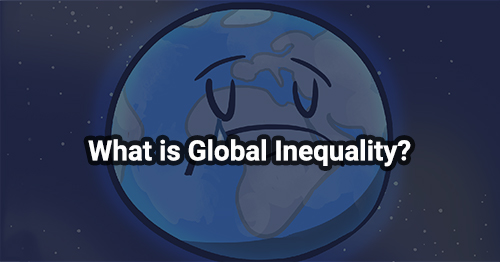What is Global Inequality?

The world is an unequal place. It means that not everybody has the same access to the same rights, opportunities, or quality of life. A good way to understand this is to look at life expectancy.
Life expectancy refers to the average years that a group of people are expected to live, based on the year they are born. Let’s look at the life expectancy of a few countries for babies born in 2017:
Japan - 85 years
Canada - 81 years
United Kingdom - 80 years
United States - 80 years
Pakistan - 68 years
Nigeria - 59 years
Afghanistan - 52 Years
This means that if a baby was born in Japan in 2017, we can expect them to live to about 85 years old (on average). That same baby, if it was born in Afghanistan, could expect to live to about 52 years old (on average).
That’s more than 30 years difference! That doesn’t seem very fair or equal. There are many reasons for this difference, and there are many complicated factors involved. Here are just a handful of reasons and causes for global inequality:
1 - Access to healthcare. Without access to doctors, nurses, medicine, vaccines, and other healthcare needs, people are more likely to die from preventable causes. For example, what could be a simple hospital visit might take days because the hospital is far away.
2 - Economy. Some countries are poorer/richer than others. This means that they might not have roads or hospitals, or schools. Some people are also poorer/richer. It means people might not have jobs or clothing or food. Without a good economy and good jobs, people can’t afford basic needs.
3 - Political stability. Not all places have a stable government. Think of all the ways that your government is involved in your life (jobs, schooling, roads, food production, almost everything!). Without a stable government, it is hard to live in a place that is safe and healthy.
4 - Basic human rights and equality. Not all places have the same basic rights. Some places do not allow women to work or vote. Some places persecute people who are LGBTQ. There might be less rights related to job safety. There might be less rights related to disability. There might be less rights related to being a child, or a senior citizen. These places have a shorter life expectancy, especially for people who are directly affected.
5 - Geography. Some places are more dangerous naturally. If you live in an active earthquake zone, or somewhere extremely cold/hot, or live in a place surrounded by dangerous animals, it can shorten the average life expectancy of that area.
6 - Education and access to information. Education helps people make their own lives better, through jobs and opportunities. It also helps a country become better, with better solutions to their problems.
7 - Access to water, food, and sanitation facilities. Not everyone in the world has access to safe drinking water that isn’t full of bad germs or chemicals. Not everyone has access to nutritious food. Not everyone has access to proper toilets and sewers. All of these things are important to stay healthy.
Keep in mind that these factors get worse when there is more than one involved. For example, let’s imagine that you live in a place that has a lot of earthquakes but also a stable government and a good economy. You might get a lot of earthquakes, but the government would probably spend a lot of money to make sure the buildings are safe during earthquakes. On the other hand, if the government and economy was poor, the buildings might not be as stable and safe as they need to be during an earthquake.
If the world was 100 people
Another way to look at global inequality is to imagine that the world is 100 people. In reality, there are more than 7.7 billion people in the world. It’s a number that’s really hard to imagine and understand, so this lets us better understand the scope of the inequality.

This is the same as showing the whole world as a percentage. 100 people would be equal to 7.7 billion - or 100%. If so, what would 1% (or one person out of 100) of the world's population be equal to?
Before we get to the examples, ask yourself these questions. Answer them with a yes or no, and keep them in mind:
- Do most people in your family or community have a college/university degree or diploma?
- Can most people in your family or community read and write (that are old enough to do so)?
- Do you have a place to call home, with a roof and walls?
- Do you have an internet connection at home or at school?
- Are you able to get safe drinking water?
- Do you have enough good, nutritious food to eat?
Now let’s look at the world as if it was made up of 100 people:
86 people are able to read and write - 14 people cannot.
Only 7 people have a college/university degree or diploma - 93 people do not.
Only 40 people have an internet connection - 60 people do not.
78 people have a place to stay that protects them from wind and rain (a house, apartment etc) - 22 people do not.
88 people would have enough good nutritious food to eat - 1 person would be dying from starvation. Another 11 people would be undernourished (they don’t have enough good food).
91 people have access to safe drinking water - 9 people do not have a way to get clean water.
Watch the video below to see more examples of what the world would look like if it was 100 people. Some of the numbers might look a little different from the ones above, because things may have changed since the video was made.
Global Inequality - Healthcare and Immunization
Earlier, we talked about healthcare being important. If the world was 100 people, 15 people would not have access to regular health care. Out of the 15, 14 people would live their entire lives without ever having the chance to see a doctor.
Watch this video below to learn a little more about global inequality in healthcare, and why it’s so important.
As you have learned from the video, one of the most effective tools in keeping people healthy is vaccination (also known as immunization). From this section forward, we’ll be looking in more detail about immunization (with a focus on childhood immunization).
Let's take a look at what this means.
How many of you have been immunized to protect yourselves from horrible diseases like polio, tetanus, and measles? You might remember going to the clinic to get vaccines when you were younger, or lining up in school waiting to get a needle from the school nurse. Not fun, but these immunizations save you from getting all kinds of illnesses. In Canada, most children have access to vaccines. Sadly, this isn’t the case for all children all over the world.
Childhood vaccines save lives. Yet, millions of children all over the world are not getting the vaccines they need. According to the United Nations Children’s Fund (UNICEF) - a non-profit organization that helps save children's lives around the world - an estimated 1.5 million children die every year (that’s one child every 20 seconds or 4,320 children every day) from diseases that can be prevented by vaccines, such as tetanus, measles, pneumonia and rotavirus (a leading cause of severe diarrhea in infants). That means that in the time that it takes you to read this lesson, several children would have died from diseases that could have been prevented.
Why do millions of children worldwide not get vaccines? This is an extremely complicated issue, and there is no perfect way to understand it. A lot of it has to do with historical issues from the past, current political situations, and global economic policies. In this lesson, we will focus on simplified categories that UNICEF has used to explain the cause - but just remember that it is much more complicated than what we can cover in this lesson. These three simplified reasons are:
-
Lack of Funding (money) & Poverty: Many public health systems, which include things like vaccine clinics, are underfunded (don’t have enough money). This means that there may not be enough vaccines, enough health workers trained to give vaccines, or enough places for children to get vaccines. This often affects children who are poor or live in remote regions (areas far outside of cities or towns) the most. When this happens, a “poverty-trap” can happen (you'll learn more about this later).
-
Vaccine Misinformation: Sometimes families are given no information or wrong information about immunization. As a result, they may not know when or why to get their children immunized, or they may have fears about vaccines that are not based on truth.
-
War and Violence: When countries are at war, health care systems are damaged. As a result, there are often fewer or no vaccines available, fewer or no trained health workers to give vaccines, and fewer or no places for children to get vaccines. War also makes it unsafe and harder for health workers to reach children with vaccines.
In the next three lessons, you will learn more about these three main reasons why millions of children don’t get vaccines.

All lessons & quizzes are free!
This was just one of the lessons in our Global Inequality section. There are over 60 lessons on Kids Boost Immunity just like this one on a variety of subjects. Each lesson includes a quiz, and every time a student scores 80% or higher on a quiz, we will donate life-saving vaccines to UNICEF Canada. Sign up now!



